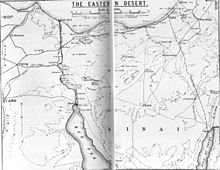Battle of Buqqar Ridge
Egyptian Expeditionary Force Yildirim Army Group The Battle of el Buqqar Ridge took place on 27 October 1917, when one infantry regiment and cavalry troops of the Yildirim Army Group, attacked the 8th Mounted Brigade of the Egyptian Expeditionary Force (EEF) in the last days of the stalemate in Southern Palestine during the Sinai and Palestine campaign of World War I.
The commander of the Yildirim Army Group ordered the reconnaissance in force, which greatly outnumbered the Yeomanry in the mounted brigade, holding the outpost line.
Despite a large number of casualties, one group made a slight withdrawal to subsequently hold their ground, until reinforcements arrived and the attackers withdrew.
Four days later, two infantry and two mounted divisions launched the EEF's Southern Palestine Offensive, with the Battle of Beersheba on 31 October 1917.
During the six months stalemate following the Second Battle of Gaza, the el Buqqar ridge had been the objective of Desert Column/Desert Mounted Corps strategic marches on 5–7, 10 May and 2–3, 6–7, 14 and 24–5 June.
The Ottoman attackers were driven back from close quarters by yeomanry rifle and Hotchkiss machine gun fire.
Both these attacks had been covered by Ottoman high explosive and shrapnel fire, from the direction of Abu Irgeig and north of Bir Ifteis.
[17] On 24 October the 53rd (Welsh) Division (XX Corps) concentrated between Hisea and Shellal on the Wadi Ghazzeh in the center of the line.
[18] During the evening the New Zealand Mounted Rifle Brigade left El Fukhari on a night march to Esani 15 miles (24 km) away.
[20] General Erich von Falkenhayn, the Commander of the Yildirim Army Group, planned a two phase attack beginning with a reconnaissance in force from Beersheba on 27 October.
[21] The reconnaissance in force was made by 3,000 Ottoman infantry, 1,200 cavalry, and twelve guns, which advanced from the Kauwukah defences in front of Tel el Sheria, to attack the EEF outpost line.
Most of the left section stretching north, was lightly held by standing patrols strongly supported in the rear, by an entrenched infantry brigade of the 53rd (Welsh) Division.
However, the 3 miles (4.8 km)-long section on the right, stretching from el Buqqar to the west of Bir Ifteis "was to be held at all costs", supported only by the Hants Battery RHA.
A squadron of the City of London Yeomanry in reserve advanced, also under heavy fire, to occupy a position 200 yards (180 m) south of the threatened post and stopped the Ottoman forces from completely surrounding it.
The squadron managed to hold out there, during the day against odds of 20 to one when the attackers closed to within 40 yards (37 m) causing four deaths and wounding 14 yeomanry.
[26] Heavy rifle and machine gun fire with occasional artillery shells was reported at 06:55 being targeted on the yeomanry garrison on el Buqqar ridge, and at 07:55 they were continuing to hold their ground on Point 720.
Two hours later, as one infantry brigade, two squadrons of cavalry and two batteries were attacking Ottoman forces as they moved towards Points 720 and 630 they were heavily shelled at 10:30 causing the reinforcements to fall back.
The 3rd Light Horse Brigade reported to the Australian Mounted Division at 14:37 that Ottoman forces were holding Point 720 on a front 1 mile (1.6 km) long, "in strength."
[8] Units of the Egyptian Labour Corps moved forward from Shellal to complete the water pipeline to Karm, and to uncovered their camouflaged work on the railway east of the Wadi Ghuzzee.
The size of the force, and its objectives are unknown, nor does the commander of the Eighth Army, Kress von Kressenstein mention the order to attack.



